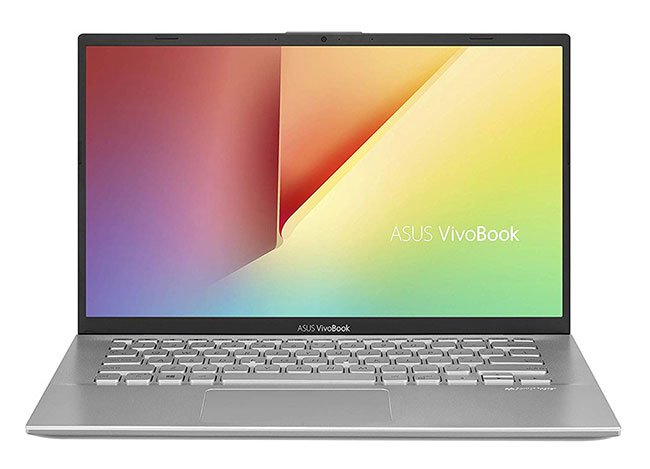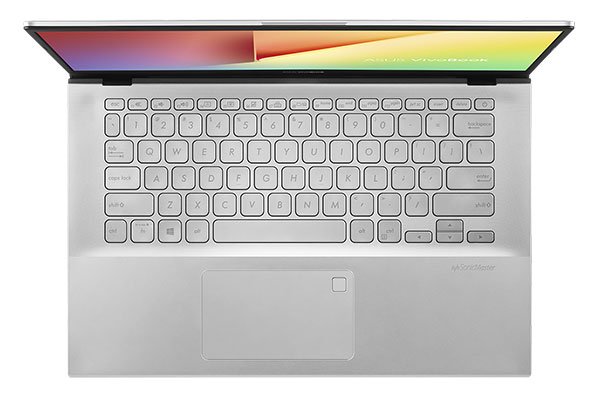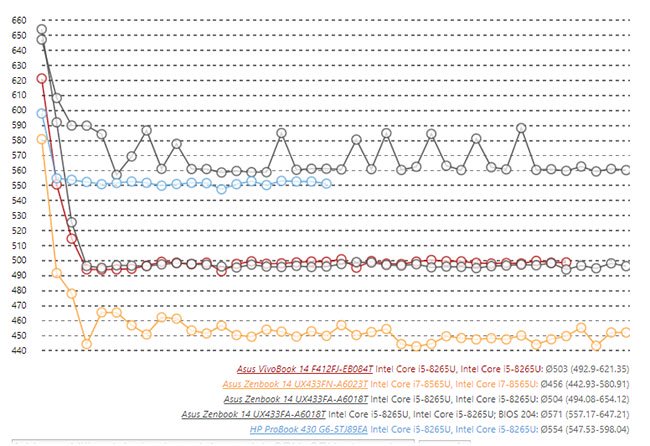Asus VivoBook 14 laptop review: Meet the needs of everyday use
The Asus VivoBook series has been expanded with a 14-inch ultrabook, equipped with dedicated Nvidia GeForce MX230 graphics, inside is an Intel Core i5-8265U chip.
So is the new Asus VivoBook 14 good? Let TipsMake.com evaluate the details of this laptop through the following article.
Specifications of Asus VivoBook 14
- Processor : Core i5-8265U, 4 cores, TDP 15 Watts
- Graphics: NVIDIA GeForce MX230
- Memory: 8192MB
- Screen : 14 inches (16: 9), 1920 x 1080 pixels, 157 PPI
- Motherboard : Intel Cannon Lake-U PCH-LP Premium
- Weight : 1.46 kg
- Reference price : VND 20,600,000
 Asus VivoBook 14 laptop review: Meet the needs of everyday use Picture 1 Asus VivoBook 14
Asus VivoBook 14 laptop review: Meet the needs of everyday use Picture 1 Asus VivoBook 14 Outer casing and connection
With a price of more than 20 million, users have a laptop with an exterior combining 2 materials of plastic and aluminum, looking very luxurious. The hinge part is also very solid.
Thanks to its compact structure and weight of only 1.46kg, Asus VivoBook 14 is the perfect companion for any situation.
As on the ZenBook series, the Asus VivoBook 14's integrated SD card reader shows significant weaknesses. The review device achieved a reading speed of 25MB / s, about 1/3 of the average on a laptop of the same type.
On the other hand, the WiFi module (Realtek RTL8822BE chip) is very fast (up to 866 Mb / s). VivoBook 14 achieves speeds of over 600 Mb / s in real-world tests.
Input devices
VivoBook comes with a chiclet keyboard with rounded keys. The keys are 15mm wide (smaller than the keys on MacBook Pro 13). The keyboard also has a backlight and provides 3 light levels.
The touchpad measures 10.5 x 6.1cm (big enough). A fingerprint scanner is also included in this area, but can sometimes be uncomfortable.
Overall, despite some weak points, the Asus VivoBook 14 is still suitable for everyday use.
 Asus VivoBook 14 laptop review: Meet the needs of everyday use Picture 2 VivoBook comes with a chiclet keyboard with rounded keys
Asus VivoBook 14 laptop review: Meet the needs of everyday use Picture 2 VivoBook comes with a chiclet keyboard with rounded keys Screen
VivoBook 14 has a Full HD display with stable viewing angles. However, brightness, averaging only 256 cd / m2, is a weakness. According to the Calman test, color reproduction and grayscale are quite good, thanks to IPS panels.
Under low light, Asus VivoBook is powered by a matte screen, so there is no reflection obstructing the working process. Unfortunately, this laptop is not suitable for outdoor use.
Efficiency
Asus VivoBook is available in black, blue and silver. It is equipped with a 256GB SSD, 8GB RAM, Intel Core i5-8265U quad core and dedicated Nvidia GeForce MX230 GPU
Processor
The Intel Core i5-8265U processor is built using Whiskey Lake architecture and has a clock speed of up to 3.9GHz (3.7GHz with all 4 cores). The performance of this CPU is sufficient to use at a standard level, even enough to run slightly more demanding software and games. Take a look at the CPU clock speed during a long download with Cinebench R15.
It can be seen that the result decreased by 120 points (equivalent to 20%) after only a few runs. High clock speeds can only be maintained for a short time. After the second run, the CPU varies from 2.2 to 2.4GHz, which is why the score is lower. However, the machine still reached the base speed of 1.6GHz and did not accelerate during the test.
 Asus VivoBook 14 laptop review: Meet the needs of everyday use Picture 3 High clock speeds can only be maintained for a short time
Asus VivoBook 14 laptop review: Meet the needs of everyday use Picture 3 High clock speeds can only be maintained for a short time The current VivoBook with Nvidia GeForce MX230 performs significantly worse than the HP ProBook 430 G6 in the long test. It should also be noted that a maximum of 600 points can only be reached after performing a cool boot.
System performance
Two advantages of fast storage and relatively good performance are found in this 14-inch Asus laptop. PCMark 10 results are not too positive in all aspects. The small downside to creating digital content may be due to the heat issue. Overall, the overall results are still acceptable.
Graphics card
VivoBook 14 boasts Nvidia GeForce MX230, which can handle everyday use. This dedicated graphics card is built with Pascal architecture from Nvidia. In this configuration, the GPU comes with 2GB DDR5 memory. The clock speed is 1519MHz (1531MHz after Boost).
The GeForce MX230 is about 10% higher than 940MX, but 20-40% lower than the GeForce MX150.
As soon as the laptop is disconnected from the power source, the graphics start working with about 16% lower performance (according to the 3DMark 11 test). Therefore, the performance potential is completely unattainable when using a laptop in an unplugged state.
Gaming performance
The Nvidia GeForce MX230 is not a typical gaming graphics card. However, some games can still be enjoyed on VivoBook. Most modern games (around 2019, 2018) can only be played at low quality. Overall, it can be concluded that the dedicated graphics card used here is slightly faster than the Nvidia GeForce 940MX.
Noise and temperature when running
Noise level of Asus VivoBook 14 is still at a moderate level (38dB).
Whether used normally or at a high level, there's always a concern that Asus laptops will overheat. The hottest point on the device reaches 45 ° C (located on the upper left of the keyboard).
The stress test is particularly interesting, as it measures core temperature and internal clock speed when operating at maximum.
Right after a few minutes, the CPU had to regulate a lot. The maximum core temperature is reached, exceeding the limit of 90 ° C. The CPU can then remain below 75 ° C, when the clock speed drops.
Speak
The stereo speakers are loud enough for you to enjoy videos on YouTube or make regular video calls. The sound quality is a bit poor for playing music.
Energy consumption
When not in use, the Asus VivoBook 14 doesn't consume much power, only consuming between 3.7 and 8.3 Watt to maintain operation. When operating at maximum, this capacity increases to 61.6 Watt. On average and while running 3DMark, power consumption decreased from 43 Watt (maximum) to 31 Watt (average).
Battery life
ZenBook 14's internal hardware is upgraded with VivoBook 14 through the use of dedicated graphics cards. This extra power affects battery life. But instead of being equipped with a 50Wh battery like ZenBook, VivoBook only comes with a 37Wh battery. The difference can be clearly seen in actual WiFi testing. The device is rated for a battery life of 5.5 hours.
Conclude
To meet daily needs for office work, enjoy multimedia content and play games, Asus offers VivoBook 14 a complete setup for more than 20 million. This Asus laptop looks very classy, although it's made of plastic. If you improve on heat and battery life a little further, this will be an option worth considering.
You should read it
- Asus VivoBook S15 review: A great, comprehensive experience
- 2019 Asus Vivobook, popular laptop with super high-speed SSD 512GB SSD storage, priced from 11.99 million
- Asus Vivobook touchscreen adds 13 and 15.6 inch size
- Asus quietly came out with a 13-inch touchscreen Vivobook laptop
- Asus introduced the new VivoBook S551 ultrabook
- Asus launched the computer market in Vietnam using Window 8
- VivoBook V551 - Ultrabook using Asus Haswell chip
- 5 attractive laptops for students cost 10-15 million VND
- Asus introduces touch ultrabook for $ 700
- Asus can offer a 10-inch touchscreen laptop with a 5-hour battery
- Laptop Windows 8 two screens of Asus
- The first 5 laptops use Haswell chips to Vietnam
May be interested

HP Envy 17: Configuration, price and outstanding features

Review Huawei MateBook 13: An attractive ultraportable laptop

Review Asus ExpertBook P3540 - The world's lightest 15-inch business laptop

Review Lenovo ThinkPad L390 Yoga: Great feature, affordable

Review Notebook 9 Pro: Performance, battery life and good price

Review Asus ZenBook 14 UX433F: A 14-inch full-screen laptop






 Asus VivoBook S15 review: A great, comprehensive experience
Asus VivoBook S15 review: A great, comprehensive experience 2019 Asus Vivobook, popular laptop with super high-speed SSD 512GB SSD storage, priced from 11.99 million
2019 Asus Vivobook, popular laptop with super high-speed SSD 512GB SSD storage, priced from 11.99 million Asus Vivobook touchscreen adds 13 and 15.6 inch size
Asus Vivobook touchscreen adds 13 and 15.6 inch size Asus quietly came out with a 13-inch touchscreen Vivobook laptop
Asus quietly came out with a 13-inch touchscreen Vivobook laptop Asus Zenbook 15 laptop review: Compact, comfortable keyboard
Asus Zenbook 15 laptop review: Compact, comfortable keyboard Review Asus ExpertBook P3540 - The world's lightest 15-inch business laptop
Review Asus ExpertBook P3540 - The world's lightest 15-inch business laptop